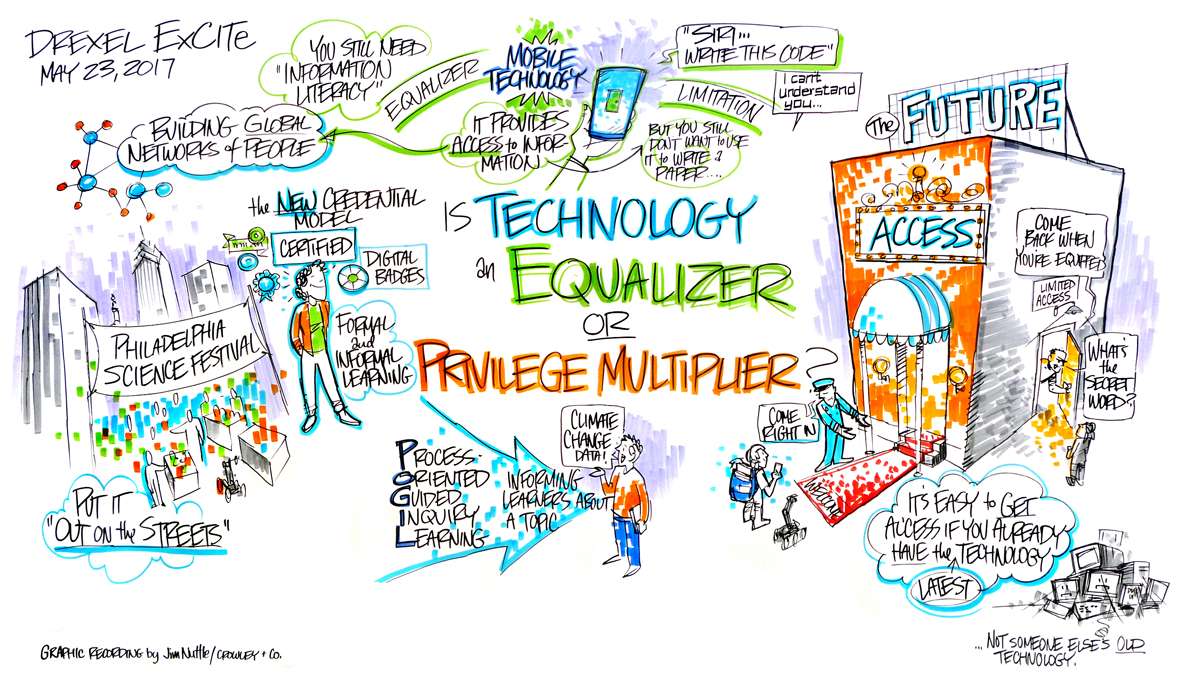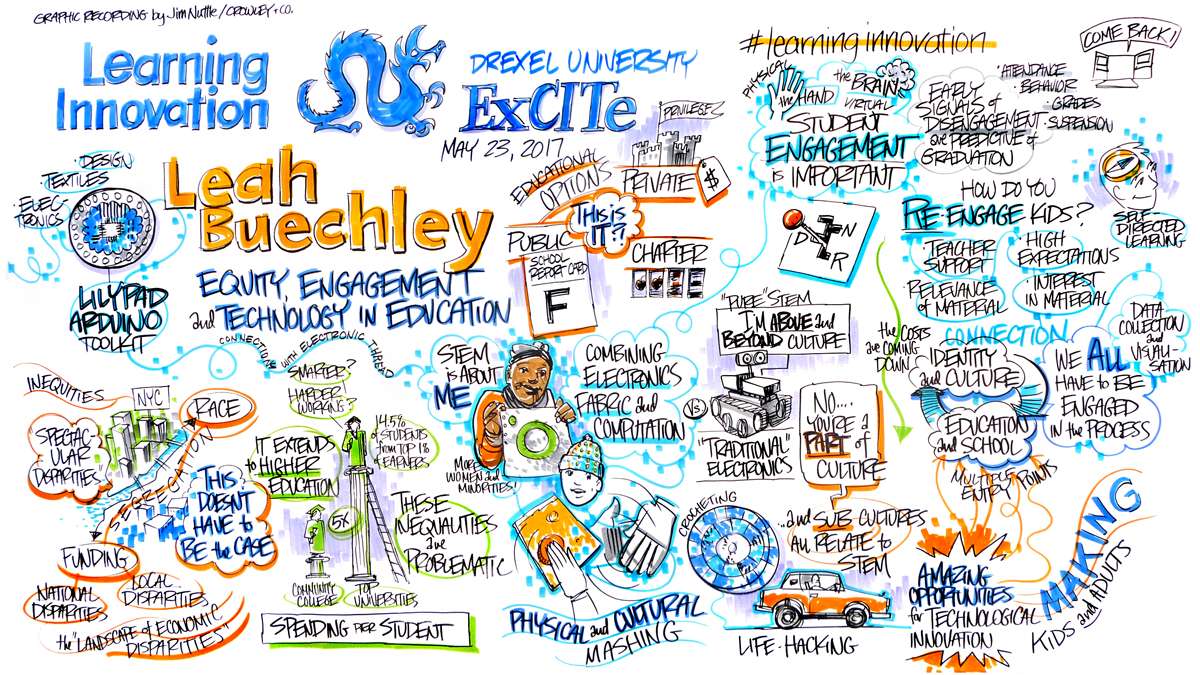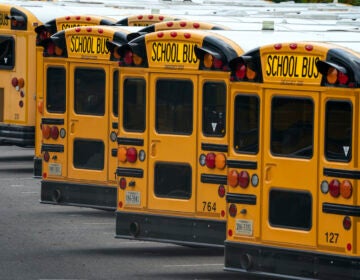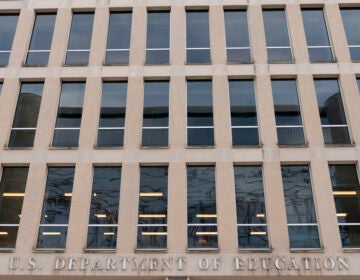Does technology exacerbate educational inequality?
Designer, engineer, and educator Leah Buechley has spent her career encouraging kids, particularly girls, to experiment creatively with technology. Now that she is looking to enroll her young son in school, she is coming up against a dilemma: Do the technologies and new approaches to learning that she has advocated for create opportunities for all students, or do they exacerbate inequality?
When Buechley came to Philadelphia recently to make a presentation for the Learning Innovation project of Drexel University’s ExCITe Center, she shared some personal and professional angst about the state of educational inequity in our society.
There are no easy answers to her questions, as Buechley wrote in an essay.
“In my career as a researcher and designer I’ve worked to nurture young people’s interests and passions by engaging them in playful creative projects that blend technology and art. I’ve developed tools that enable kids to make pop-up books that sparkle and change shape, and clothing that sings. I’ve helped develop some of the first female-dominated computing and electronics communities.
“In all of this work, I’ve focused primarily on what young people do outside of school, guided by the belief that the things kids are most interested in and excited about shape their lives at least as much as the classes that they take. I’ve mostly evaded the political and economic complexity of the educational system, designing tools and activities that are used primarily at home or in after school programs.
“I’m proud of the work that I’ve done, but as my own child approaches school age, the choice to avoid classrooms feels increasingly problematic. In beginning to look for schools for my son, I’m being confronted personally with the heartbreaking inequities and tensions that are built into the school system — the enormous disparities in resources available to different communities, the concentration of minority kids into low performing high poverty schools, and the uncomfortable choices faced by caring parents.
“Many of the most significant challenges society faces are rooted in our educational system. By avoiding classrooms, have I been sidestepping all of the hardest and most important problems? Have I made some of these problems worse?”
These are questions that many Philadelphia educators face. We asked for responses from the audience who attended Buechley’s presentation.
Train the teachers, not just the students
“I have given workshops on computing for elementary school students from diverse backgrounds in several schools and public libraries. In my experience, students have been uniformly excited by, and creative in, exploiting the technology. Whatever the problem is, it is not the students!
“From my perspective, providing technology resources (e.g., computers and maker spaces) does not by itself do enough to solve the problem — whether it be raising technological literacy or alleviating educational disparity. Resources, once provided, are too often unused or used in unimaginative ways.
“A variety of reasons produce this result. It is easier to raise money for equipment than for teacher training. Educational institutions may lack guidance for using computers other than for drill and practice. There is little time in the school day to devote to activities not directly related to preparing students for standardized tests. Teachers may need help in overcoming fears that they will expose their ignorance about new technologies, and thereby lose their students’ respect.
“What’s needed are consulting and professional development services that help school administrators and teachers overcome these obstacles. They need to know that, if their students can do it, so can they!”
—Dr. Stephen J. Garland, founder of Promoting Computer Literacy in Children
Purpose and direction
“As an educator in various spaces in Philadelphia, I find that technology has potential to improve educational disparities, but it often falls short. Without having thorough intentions for implementing technology, many educators end up viewing tech as a distraction, and limiting it to few purposes such as typing or research.
“Worse still, there are schools and programs which give out laptops for home and school use, but give little direction about how to maximize use of the laptop.
“While working in an afterschool program where many teen students went to cyber schools, I was shocked that they merely used their laptops for completing traditional writing assignments, but did virtually nothing with media applications, programming, or other in-depth usage.
“In my experience, students will continue to use technology in their own ways, which can have positive, negative, or neutral effects. In one outstanding case, technology access allowed for a 15-year-old student to become an entrepreneur offering art and photography creative services throughout the city. However, the majority of this student’s peers lacked a sense of direction in their use of the laptops or other technologies. Nor did their school leadership have an angle for building upon their interests and skills. While one student figured out their own means of creating success, the implementation of tech as a whole missed the mark.
“Essentially, technology access gives the opportunity for scholars’ achievements, but lack of direction leaves a gaping canyon between access and success.”
—Khyra Lammers, culinary literacy outreach specialist at Free Library of Philadelphia Foundation
Considering cost and curriculum
“We know that an understanding of [technology and computing] is essential, not only to prepare students for job opportunities in the future, but also for our children to express themselves and maximize their own creative potential. These questions provided an opportunity to reflect upon something we at ExCITe are asked regularly: In a world where understanding technology is a requirement for future success, what tech tools do students and teachers need for successful learning?
“Often, this question is directed at access: What tools should my school or program have available for students to use? There’s never a simple answer to this question because it depends entirely upon the context. What are the interests of the students participating? What’s the curriculum that will support the technology use? And perhaps most importantly, what is the capacity for instructors to use the tech comfortably and confidently, using it to inspire students in a way that taps their creativity and unleashes their potential?
“Resources are too often scarce, and it’s good to be judicious in making investments. But keep in mind, there is no single tool or technology that will suddenly advance learning, without carefully considering these questions. This means stopping, before purchasing a fancy 3D printer, to ask if there is buy-in from staff and a supportive curriculum and plan to engage students.
“Of course, technology is ever-evolving, and some tools that were cost-prohibitive five years ago are now commonplace and affordable. In our Summer Music Technology program (entering its 11th year), our participants build musical robots, sound effects, and custom electronics projects using Arduino microcontrollers for well-under $50 per student — and that cost continues to decline.
“Designing such projects requires some expertise to look a few years down the technology development pipeline to extrapolate what will be most sustainable. We try to address disparities by sharing this knowledge as broadly as possible, and our lesson plans and starter code for these activities are open source and available on our program website. Again, that’s only part of the equation, and the the greater challenge and cost is the investment of time and expertise required to take a design for a musical robot and make it an inspiring learning activity.
“To help address these questions, ExCITe is conducting, a nationwide research survey of makerspaces, from kindergarten classrooms to senior high school robotics labs. This survey is particularly aimed at understanding how underserved communities can best incorporate technology and creative approaches to making to advance learning.”
—Dr. Youngmoo Kim, associate professor and director of Drexel University’s ExCITe Center
—
Learn more about future Learning Innovation presenters and the project’s survey project.
WHYY is your source for fact-based, in-depth journalism and information. As a nonprofit organization, we rely on financial support from readers like you. Please give today.






